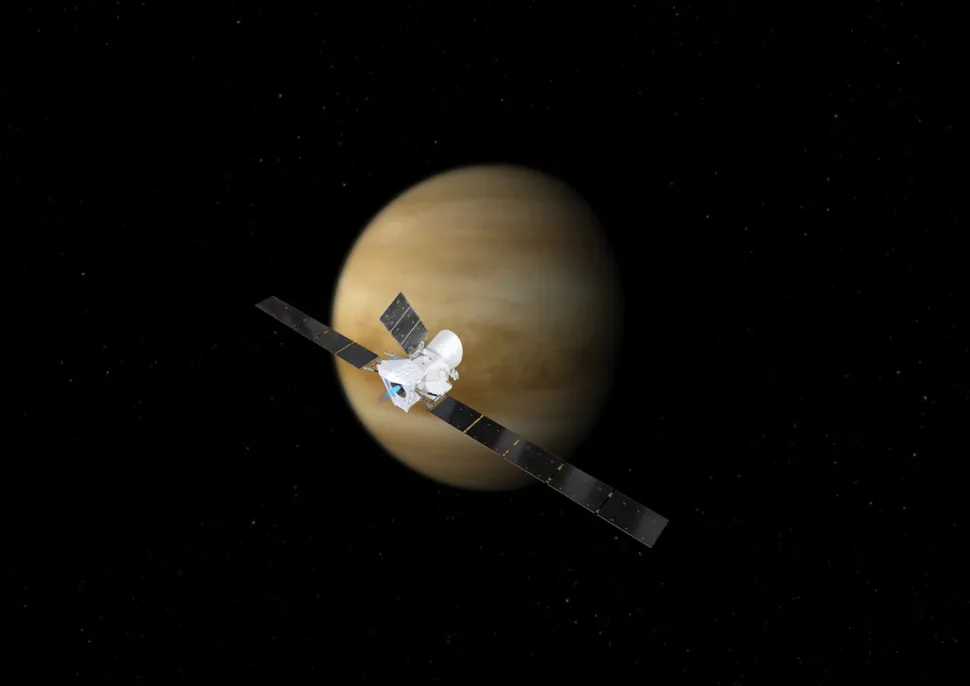The BepiColombo spacecraft, operated by the European Space Agency (ESA) and Japan Aerospace Exploration Agency (JAXA), could be feeling the heat even before it reaches its destination: Mercury. Thanks to a glitch, the spacecraft’s thrusters are no longer operating at full power. The team has yet to determine how this will impact upcoming maneuvers, like a Mercury flyby set for later this year.
Destined to become just the second mission to orbit Mercury when in December 2025, BepiColombo is composed of two probes and something called the “Mercury Transfer Module” that scientists hope will answer many perplexing questions about the smallest planet in our solar system. (To be clear, BepiColombo has performed Mercury flybys before, but is yet to actually enter Mercury’s orbit.)
These questions include things like how Mercury can be so blisteringly hot, yet have ice in its polar craters, why the planet has a weak magnetic field, and what the mysterious hollows seen on its surface are.
The 48-million-mile-long (77-million-kilometer-long) journey to Mercury is far from straightforward for BepiColombo; the spacecraft will make a total of nine planetary flybys before being inserted into the relatively tiny planet’s orbit. And, as ESA reports, the glitch experienced by the spacecraft on April 26 has complicated this journey further.
BepiColombo, which launched on October 20, 2018, from ESA’s launch facility in Kourou, French Guyana, atop an Ariane 5 rocket, experienced the glitch as it was preparing to execute a maneuver in space that would help prepare it for its fourth flyby of Mercury on Sept. 5, 2024.
The Mercury Transfer Module is equipped with solar arrays and an electric propulsion system used to generate thrust. As the spacecraft was about to begin its April 26 maneuver, however, operators found that the Transfer Module had failed to deliver enough electrical power to its thrusters.
As soon as the fault was identified, ESA operators set about rectifying it. By May 7, the team had restored power to the thrusters such that they reached 90% full capacity, but the power available from the Mercury Transfer Module is still below what it should be. This means BepiColombo is continuing to operate without its full thrust.
ESA said the main priorities of the BepiColombo team currently are to keep the spacecraft’s thrust stable at its current sub-optimal levels, and to work out how the spacecraft will handle upcoming maneuvers at less than full propulsion. Operators are also working to determine what caused the drop in power and assess if full power can indeed be restored.
During its journey to Mercury, BepiColombo completed one flyby of Earth on April 10, 2020, and two Venus flybys on Oct. 15, 2020, and Aug. 10, 2021. During these later flybys, the spacecraft collected important scientific data about Venus, which is the second planet from the sun and hottest world in the solar system.
BepiColombo made its first Mercury flyby on Oct. 1, 2021, with its second and third flybys following on June 23, 2022, and June 19, 2023. As mentioned above, the fourth flyby of Mercury is set for Sept. 5 this year, with a fifth and sixth flyby of the first planet from the sun set for Dec. 2, 2024, and Jan. 9, 2025.
ESA has yet to reveal if or how the thruster glitch will affect these operations or the overall timeline of the mission, which is set to end on May 1, 2028, after BepiColumbo will have spent 10 Mercury years in orbit around the tiny planet.
Source: https://www.space.com/bepicolombo-spacecraft-mercury-thruster-glitch



